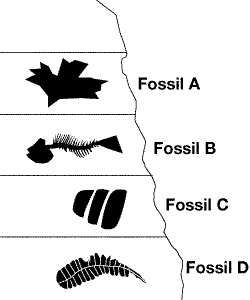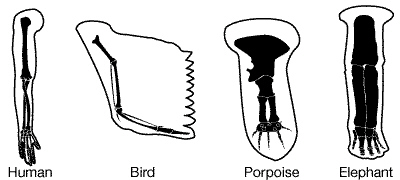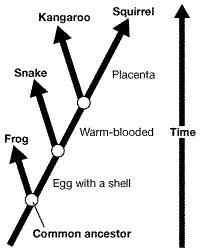Modified True/False
Indicate
whether the statement is true or false. If false, change the identified word or phrase to make the
statement true.
|
|
|
1.
|
An adaptation is an inherited trait that helps an organism
survive. ____________________
|
|
|
2.
|
Each branch of a cladogram represents the same evolutionary paths.
____________________
|
|
|
3.
|
Species that share more similarities in their DNA are more closely
related than those that share fewer similarities. ____________________
|
Multiple Choice
Identify the
choice that best completes the statement or answers the question.
|
|
|
1.
|
The process of how organisms acquire adaptations over time is called:
a. | evolution. | b. | adaptation. | c. | selective
breeding. | d. | natural selection. |
|
|
|
2.
|
The relationship among living species and their ancestors is shown in:
a. | a cladogram. | b. | an evolutionary diagram. | c. | a
timeline. | d. | None of the above |
|
|
|
3.
|
Scientists have collected many fossils of horse ancestors. The use of fossils to
trace the evolution of the horse is known as:
a. | DNA analysis. | b. | the fossil record. | c. | comparative
anatomy. | d. | comparing embryos. |
|
|
|
4.
|
Which fossil is the oldest in the drawing below?  a. | Fossil A | c. | Fossil C | b. | Fossil B | d. | Fossil D |
|
|
|
5.
|
Scientists believe that the first life appeared over ____ on Earth in the form
of tiny, single-celled prokaryotes.
a. | over 3 billion years ago | b. | 2 million years ago | c. | 4.6 million years
ago | d. | 460,000 years ago |
|
|
|
6.
|
Scientists have evidence that ____ first appeared 40,000 years ago.
a. | dinosaurs | b. | primate ancestors | c. | mammals | d. | modern humans |
|
|
|
7.
|
Scientists believe that the earliest cells on Earth were simple, and that over
time, more complex cells developed from these simple cells. This describes:
a. | the fossil record. | b. | comparing embryos. | c. | evolution. | d. | artificial
selection. |
|
|
|
8.
|
As a populations’ habitat changes over time, which species would have a
better chance of survival?
a. | A species with a high level of variation | b. | A species that feeds
only on one type of food | c. | A species with a low level of
variation | d. | A species that rarely mutates |
|
|
|
9.
|
 The picture shows
the same piece of anatomy for 4 different species. The structures shown are referred to as: a. | analogous structures. | c. | homologous structures. | b. | vertebrates. | d. | arms. |
|
|
|
10.
|
Evidence for evolution can be found in:
a. | DNA analysis. | b. | comparative anatomy. | c. | the fossil
record. | d. | All of the above |
|
|
|
11.
|
When studying DNA base sequences of different species, it is known that species
that share:
a. | more similarities are more distantly related. | b. | fewer similarities
are more closely related. | c. | fewer similarities have an evolutionary
relationship that is close. | d. | more similarities are more closely
related. |
|
|
|
12.
|
Most fossils are dug from:
a. | Sedimentary rock layers. | b. | Earth’s outermost
layer. | c. | Earth’s crust. | d. | All of the
above |
|
|
|
13.
|
All of the following are usually required for fossil formation EXCEPT:
a. | an organism’s body is slowly covered in sediments. | b. | an organism’s
body is quickly covered in sediments. | c. | more and more sediments cover the remains over
time. | d. | the chemicals in the body parts are replaced with rock-like
minerals. |
|
|
|
14.
|
Why are cells considered evidence for evolution?
a. | Cells are not considered to be evidence for evolution. | b. | All cells are traced
back to different origins. | c. | There are striking similarities among all
cells. | d. | There are a large variety of cells in organisms. |
|
|
|
15.
|
In the cladogram below, which two species have the weakest evolutionary
relationship?  a. | Squirrel and Snake | c. | Kangaroo and Snake | b. | Squirrel and Frog | d. | Squirrel and
Kangaroo |
|
|
|
16.
|
What type of structures are bird wings and moth wings?
a. | Ancestral structures | b. | Similar structures | c. | Homologous
structures | d. | Analogous structures |
|
|
|
17.
|
Certain lizards have coloring that allows them to blend into the background of
their environment to hide from predators. This is an example of a(n):
a. | evolutionary mechanism. | b. | homologous structure. | c. | adaptation. | d. | behavioral
characteristic. |
|
|
|
18.
|
The fossil record is incomplete because:
a. | many ancient species did not fossilize. | b. | scientists have not
devoted effort and funding for fossil digs. | c. | many fossils are found deep on the
ocean’s floor. | d. | All of the
above |
|
Completion
Complete each
statement.
|
|
|
Select the correct term to complete each sentence. There are extra terms in
the list.| embryos | artificial selection | natural selection | | Thomas Malthus | Charles
Darwin | base sequences | | extinction | variations | differentiation | | adaptation | Earth’s core | sedimentary | | evolution | ancestor | cladogram | | 4.6 billion | 100,000 | common ancestor | | | |
|
|
|
1.
|
The process of how organisms acquire adaptations over time is called
____________________.
|
|
|
2.
|
An organism from which others have descended is referred to as an
____________________
|
|
|
3.
|
Scientists believe that Earth is about ____________________ years old.
|
|
|
4.
|
Another word for a branching diagram is a ____________________.
|
|
|
5.
|
The rock layers from which most fossils are dug are ____________________.
|
|
|
6.
|
DNA is used as evidence for evolution because species with more similarities in
their _________________________ are more closely related than those with fewer similarities.
|
|
|
7.
|
By studying the ____________________ of a fish, calf, and rabbit, scientists can
conclude that they all come from a common ancestor.
|
|
|
8.
|
A hummingbird’s long beak helps it get nectar from flowers. This is an
example of an ____________________.
|
|
|
9.
|
Darwin hypothesized that the different finches on the Galapagos Islands all had
a ______________________________.
|